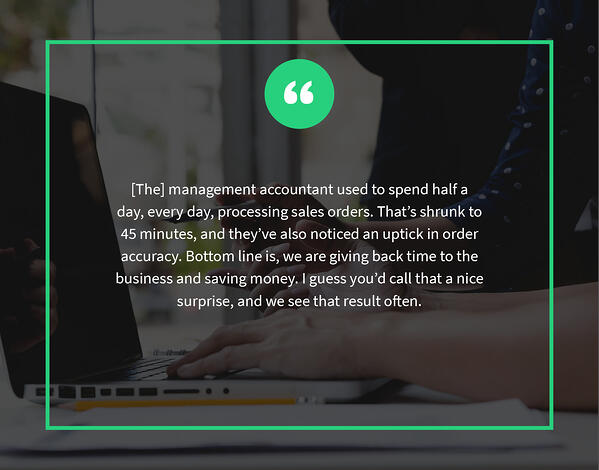Demystifying Business Automation - Interview with Craig Pellett, CEO of Streamline

About Craig Pellet:
Craig Pellet is chief executive officer of Streamline, the back-office automation specialists. He’s inspired by two things: technology and growing great companies. One of the few people to found and then float a New Zealand-based technology company, Craig’s passion today is the automation of repetitive business functions of all kinds, harnessing intelligent and customisable workflow technologies to unlock real efficiencies for streamline’s customers. Delivered over the cloud, streamline solutions boost productivity, cut error rates and slash the costs of compliance.
Craig let’s start with the basics. What is business automation?
The easy explanation: it’s putting technology to work to process the mundane and repetitive tasks currently performed by people. In most cases, automation replaces the most tedious parts of a role, but not the entire role. Automation is at its best with processes that require accuracy but not a lot of creative thought.
Let me use accounts payable as an example. Historically AP has been about extracting information from an invoice document and manually inputting it into an accounting system. This means skilled AP staff members often do data entry work for a good portion of their day. Streamline’s back office automation suite includes a cloud-based AP automation solution called PlusOne. It eliminates 50 to 85 percent of that manual work by automatically capturing and validating data from incoming invoices, matching them to purchase orders, routing them to the right people for approval and, when the invoice is approved, sending them on to your accounting system for payment. That’s hours in the day that become available to those staff members to devote to more productive work. There are several additional benefits, but you get the picture.
For most people, the light comes on when we explain automation in terms of their own job. Usually I explain automation in those terms and talk about the drudgery and the tedium that we take out of certain functions. That’s when it starts to make sense.
People in business understand that automation is happening all around them, but do they always have a clear picture of what it means for their business?
I’m old enough to have seen automation taking place over decades in various forms and business sectors, so it’s not new. What we’re seeing now though is the increased pace of change. That brings with it a level of uncertainty and, to some degree, that uncertainty is reasonable. Technology has delivered simplicity, but it can also deliver complexity.
An example is the fragmentation of technology offerings; different companies providing parts of the answer. Think about someone running a restaurant; he or she has the option of many different systems for ordering, for accounts payable, for accounts receivable. Plus, there’s different ways of delivering those systems. Should you run them in the cloud or not?
From the inside, it can be bewildering. You suspect your business could benefit from automation, but at the same time, you are not sure what and how.
So where do you start?
I start by asking people how long they’ve been in business. Generally, as businesses grow, that growth will have come without any strategic review of the processes that support the business. All the energy is on customer acquisition, which is a correct and ongoing focus.
So, if a business hasn’t reviewed those processes in, say, the last five years, I suggest first getting familiar with them, because those jobs will have been created, handed down, and handed down again, and then handed down again. When you look at those tasks, you’ll find that processes have been invented and re-invented, and you’ll be surprised at the inefficiencies that have been built it into them.
That’s where you start: with understanding what may be supporting the business from a process point of view before you do anything else.

Once you’ve got that understanding of the present state, what next?
We’re always encouraging our clients to look for the low-hanging fruit. That’s simply because the business will need confidence that the investment in automation will pay off. Early successes return cash and time to the business and sharpen the appetite for the next stage.
Secondly, we always look for a destination. The business objectives behind the automation. With that clearly established, you can logically move on to project B once you’ve finished project A. On the way, you’ve created headroom and released money to engage in that next part of the process.
The important thing is having that destination in mind. Otherwise, it can feel like flying around the world on multiple tickets. You land in San Francisco without a clue of how to connect to your onward flight to Chicago. That’s a recipe for frustration.
What are the guaranteed ways of getting automation wrong?
Experience shows us that the people who get it wrong have done so from an incomplete idea of the destination. Modern day business is complicated anyway. You’ve got the reason the business exists and then you’ve got all the support and compliance functions at the back end. Not understanding how some of these processes work and fit together is why some attempts at automating them fail.
In larger organisations, you often see the silo effect. Large companies often call different parts of the business divisions, and they’re called that for a reason, I think. They divide. What may appear logical and sensible for one part of that business becomes completely illogical to another part. We sometimes see evidence of problems being thrown over the fence for somebody else to deal with. That silo effect can cripple automation initiatives.
Another way to get automation wrong is to start with inaccurate or incomplete data. Automation relies on triggers – decisions made at a logic level by a piece of software. They absolutely need a reliable source of information. We actively encourage people to do data clean-up before an automation implementation starts so that we know we’re going to have good quality outcomes.
You’d expect bigger companies more advanced with automation. Are they?
Sometimes. There are plenty of examples of very large organisations that have used automation very well. One example is the NZ operations of one of the big four global professional services firms. It’s using a workflow solution from streamline that automates the engagement process with the clients of one of its principal lines of business.
Streamline Workflow provides a single working environment to complete the entire process, using feeds from several incumbent systems and streamlining the required internal assessment, approval and sign off processes.
That organisation isn’t typical, though. A lot of very large businesses are complicated, siloed, and have no-one with a complete view of the processes that keep them running. Most of these larger businesses have bought other businesses. That also causes complexity, because now you’ve got multiple systems that don’t talk to each other. You’ve got billing environments, for example, that are structured for one company and don’t work in the new environment. From a customer point of view, looking inside from the outside, it can look incoherent and frustrating. For the combined entity, it’s a level of complexity they just haven’t been able to get to grips with themselves. And in that sort of situation, the opportunity for automation becomes a lot more limited.
What surprises customers most when they automate?
The impacts vary by the size of business. But it’s very rewarding to have a customer that knew that they had to do something, probably didn’t know how they were going to get there, and then we take them on that journey, they’re surprised and delighted by the results. I’m thinking of one Queensland client in the natural skin care business that adopted a streamline document management solution and combined it with our Springboard skilled staff outsourcing solution. Their management accountant used to spend half a day, every day, processing sales orders. That’s shrunk to 45 minutes, and they’ve also noticed an uptick in order accuracy. Bottom line is we are giving back time to the business and saving money. I guess you’d call that a nice surprise, and we see that result often.
When’s the right time for the ROI discussion?
It has to be right up front. And it shouldn’t be purely in terms of dollars. For most people involved in an automation implementation within a business, the benefits will crystallise in the form of the headroom and the time they get back and can re-invest in the business. It allows them to focus on issues that are more strategic. Having that space to think and to add value to what they’re doing as opposed to just doing routine, functional compliance activities.
McKinsey & Company says fewer than five percent of occupations can be completely automated, but 60 percent of occupations can have a third of their work automated. If your business is anything like that, it pays to consider what you’re going to do with the human capacity that is released by automation. It can potentially be a huge upside for the business.
What are some of the other less obvious benefits businesses reap from automation?
One of the delightful side benefits of automation is the data that automation discovers, and which can make new comparisons and analytics possible. Take accounts payable as an example. When you follow an invoice from the time of receipt through to delivery and all the way to an ERP system, you start to see data that wasn’t easily visible before and use it create other trigger points for the business to act on.
On numerous occasions we’ve been able to highlight customer discrepancies that would otherwise have led to errors and re-work. It might be a bank account on the invoice that varies from the one the customer holds. It might be a wrong GST number on an invoice. Our systems have also highlighted potentially fraudulent activity. They’re things that human beings aren’t always going to pick up. That kind of accuracy is a by-product of automation and we’re making all those things available back to the customer, so the quality of their information and processes continues to improve.
One last piece of advice?
Recognise that automation is a topic that will have to be looked at. It’s not a case of if, but when. Putting it off is just delaying the inevitable. Now, automation won’t be appropriate for every single business, but if it’s been five years since you’ve had a look at the processes underlying your business, that’s the appropriate place to start. That review doesn’t have to be complicated. That’s my advice: just get started. Ask some questions.